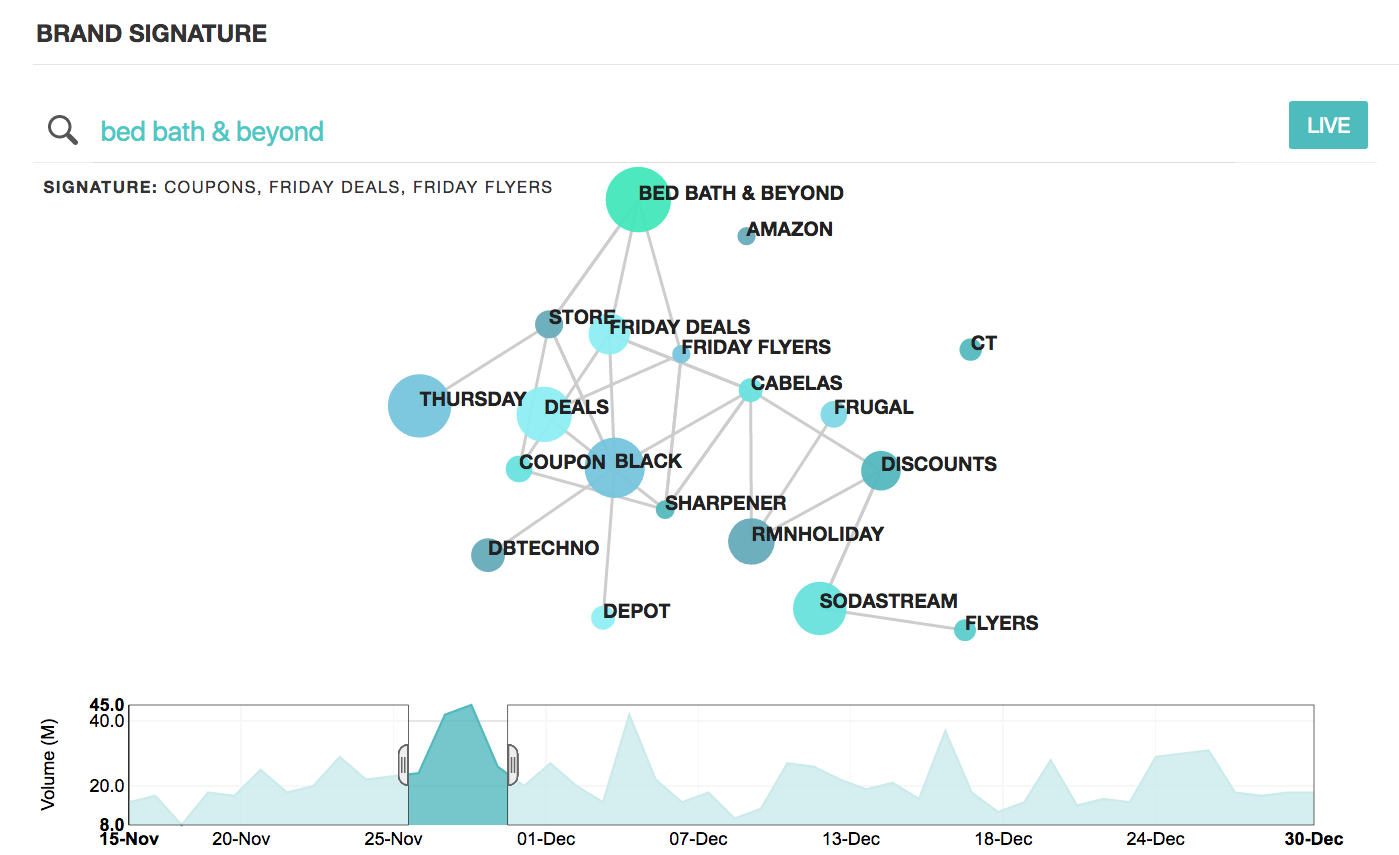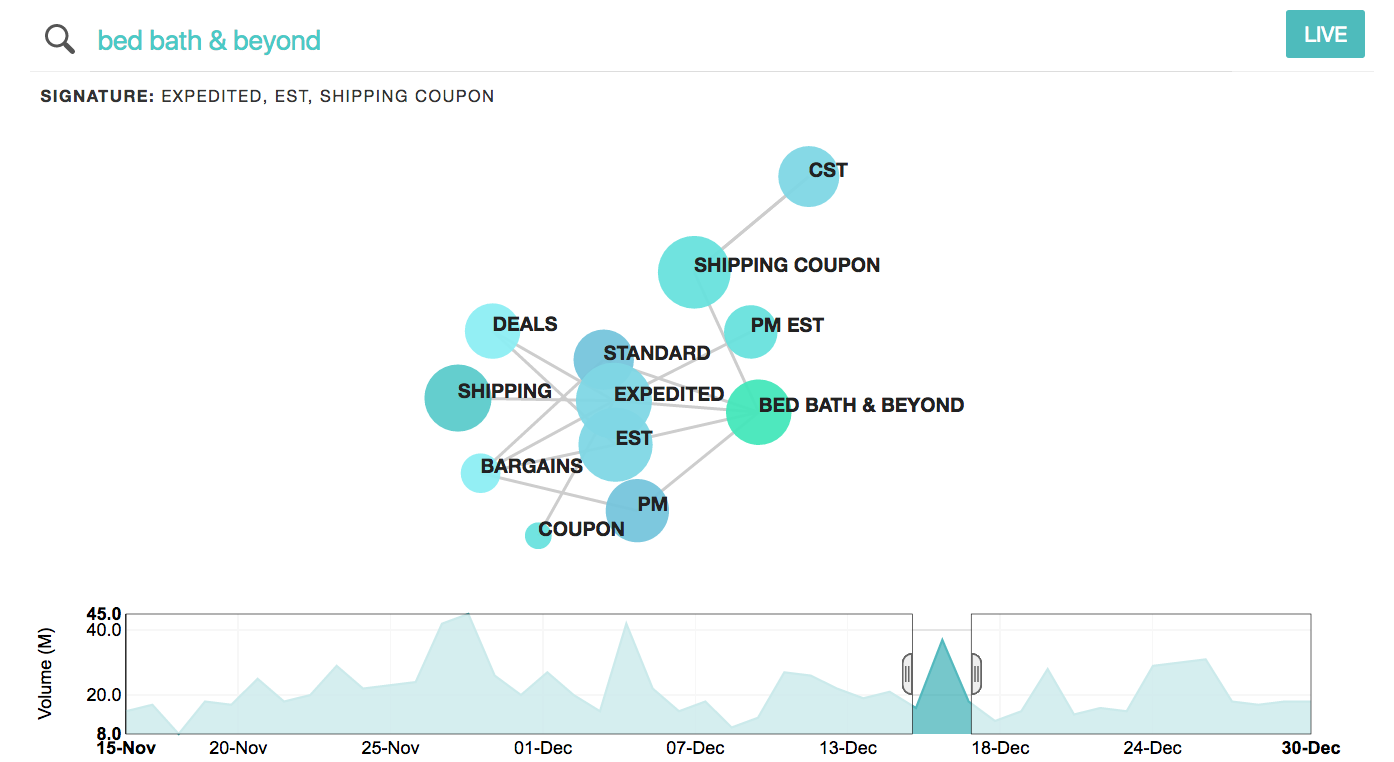Save 50% on a 3-month Digiday+ membership. Ends Dec 5.

by John Snyder, CEO, Grapeshot
What are your plans for the holidays? Are you going with the full Clark Griswold experience or something more sedate? What about gift buying? Do you see Black Friday as chance to show your strategic retail prowess or an unnecessary hoopla?
These days good old Clark is more likely to do his gift buying online rather than to schlep his family round the stores. Last year, Prosper Insight and Analytics reported that 102 million Americans visited stores across the Thanksgiving/Black Friday weekends and 103 million shopped online.
So, who benefited from what Adobe defined as a market growing 19 percent per annum now worth over $6 billion? We have analyzed all the articles being read online as well as content shared on Twitter containing the keyword “Black Friday.” The most popular words appearing in that content that will signify the brands most associated with the retail event. Retail giant Bed Bath & Beyond ramps up their Black Friday spend early, and we see keyword clusters around deals, coupons, the Friday flyer, and discounts, alongside other mega-retailers like Cabela’s.

Data reflects the 2015 holiday shopping season
One week out from Christmas, and their brand signature had shifted to focusing on last minute shoppers and expedited shipping.

Data reflects the 2015 holiday shopping season
This makes sense. BB&B was looking to reach audiences who plan around the shopping events as well as those who are more adverse– waiting to the last minute to tick everyone off their lists.
Whether you love or loathe Black Friday there’s no getting away from it. So who are the winners and losers? Outdoor clothing specialist REI make a Marketing virtue out of keeping their store doors shut on Black Friday getting 300,000 of their customers to #optoutside instead. This strategy protects customer loyalty by keeping shoppers away from all stores, and safe from competitors seductive holiday offers.
Ad position: web_incontent_pos1
Curious about other Black Friday winners and losers we set about examining 2015 data to determine which brand messages customers were reading about and sharing on Twitter. Winners include Kohl’s, Best Buy, and Target, increasing spend around those keywords to reach gift giving audiences. P&G, on the other hand, spent almost $10M between Nov 15-30th and avoided Black Friday content entirely. The top ten categories accounting for media spend reflect the brands and products primarily discounted during Black Friday. Retail computers and consumer electronics are two categories that saw the greatest jump in spend. On Black Friday in 2015 Walmart spent almost 1,000 percent above their daily average.
Over the years Black Friday has developed a negative connotation, associated with shopper hysteria. For every article we saw featuring keywords like sales and deals, there were others about mayhem and riots. Keywords such as riot, violent, protest, and others present some of the negative aspects of this unique experience for consumers.
It’s time to finally take Black Friday by the reigns Follow these 5 tips to ensure your brand survives this Black Friday:
- Don’t wait until it’s too late: Give yourself ample time to identify key audiences and strategies used to target potential consumers in decision-making moments this holiday season. The most effective campaigns are the ones well planned out.
- Competitor conquesting: ‘Tis the season to snatch up your competitors’ customers! Utilize competitor conquesting tactics to convert those shoppers into new, jolly consumers.
- Expect the unexpected: There are some things in life you can always expect, like playing football and eating too much turkey on Thanksgiving. But what about hot, trending content? Equip your campaigns with predictive technology to ensure they’re touching the most people this holiday season.
- Measure everything: Utilize proper campaign analytics tools to report on impressions, conversions, spend, etc. to optimize current and future holiday campaigns.
- Brand safety is key: It seems every holiday season, Murphy’s law holds true. By implementing a holiday brand safety strategy, brands can protect themselves from embarrassing and tarnishing situations.
Like everything in life the advertising realm mirrors the human experience- we all hate the lines but treat it as part of the experience. We know it’s going to be hard and we also heard–and in some cases experienced–the riots and mayhem this day brings but hey- no pain no gain. Thanks to data-driven insights and advanced targeting, brands have the power to avoid content regarding negative customer experiences. On the other side of the coin, some of these experiences are what Black Friday is all about- working hard to find the best deal! One of the best customer quotes I’ve recently read describes this oxymoron perfectly- “I once got pepper sprayed while Black Friday shopping in Walmart and I can honestly say it enhanced the experience”.
More in Marketing

Ulta, Best Buy and Adidas dominate AI holiday shopping mentions
The brands that are seeing the biggest boost from this shift in consumer behavior are some of the biggest retailers.

U.K. retailer Boots leads brand efforts to invest in ad creative’s data layer
For media dollars to make an impact, brands need ad creative that actually hits. More CMOs are investing in pre- and post-flight measurement.

‘AI is permeating everything we do’: How Guitar Center developed 2 AI tools this year
This summer, the company launched a chatbot called Rig Advisor to help customers find the right instruments and products.
Ad position: web_bfu
